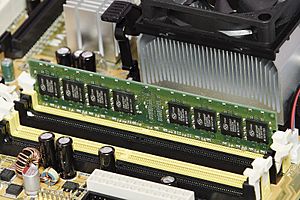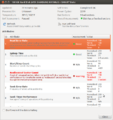Computer data storage facts for kids
Computer data storage is the name for a number of components of a computer. The main purpose of these components is to store data. The central processing unit is then able to fetch and change the data. In most computers, there is a computer memory hierarchy: Memory that is "closer" to the CPU is usually faster to access, but it is also smaller; data that is stored in this kind of memory usually needs electrical power to keep the data.
Memory that is farther away is usually slower to access, but also bigger. Examples for this kind of data are classical storage media, such as hard drives or USB flash drives. Some media offer even more capacity, but accessing them is very slow. Examples for such media are tape drives. Modern CPUs have registers that can store data, they also often have several levels of cache.
Finally, there is the main memory the CPU can access. These three are usually referred to as Primary data storage.
Secondary storage is usually not directly accessible by the CPU, and data needs to be transferred to primary storage to be available. Secondary storage includes hard drives and non-volatile random-access memory. Tertiary storage is used for archival and backup; very often it is copied to secondary storage before use. Software is sometimes distributed by tertiary media such as magnetic tape and CD-ROM.
Images for kids
-
160 GB SDLT tape cartridge, an example of off-line storage. When used within a robotic tape library, it is classified as tertiary storage instead.
-
A hard disk drive (HDD) with protective cover removed
-
S.M.A.R.T. software warning suggests impending hard drive failure
-
Error rate measurement on a DVD+R. The minor errors are correctable and within a healthy range.
See also
 In Spanish: Memoria (informática) para niños
In Spanish: Memoria (informática) para niños










